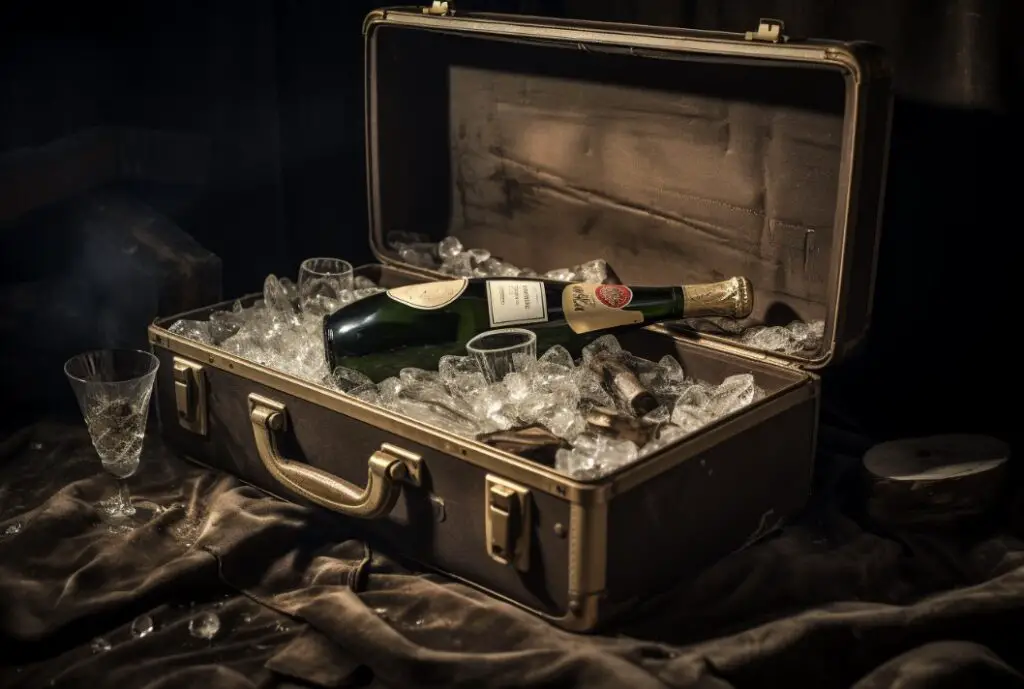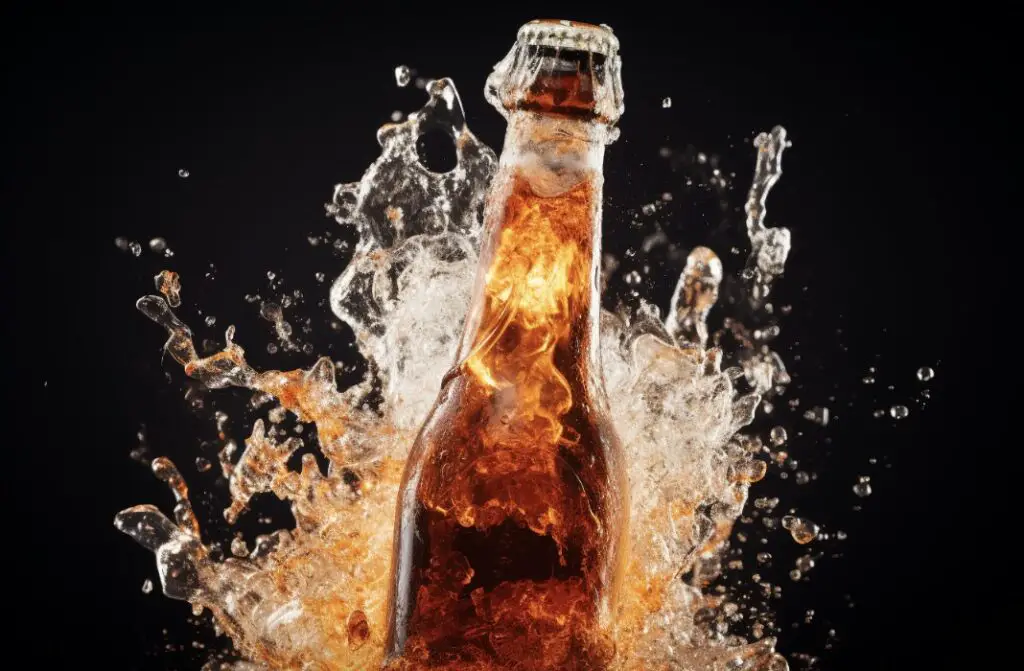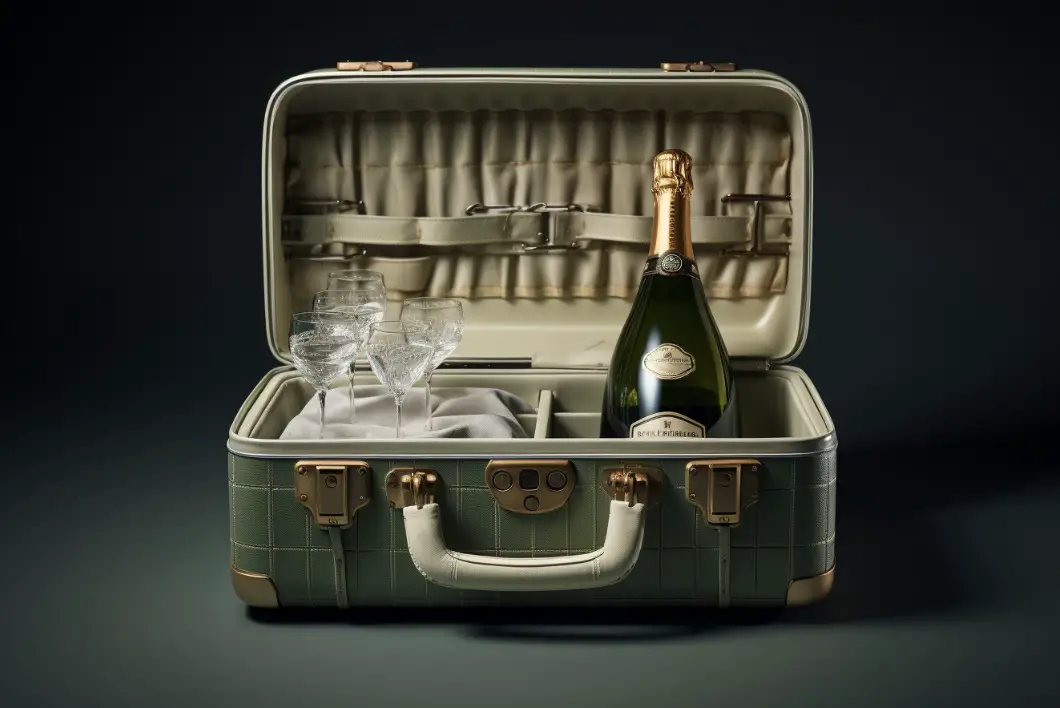As a home brewer and frequent traveler, I have often wondered if carrying my prized bottles of champagne in my checked luggage would result in an explosive disaster.
And even though I never experienced this myself (always drank my champagne before flying…), I have spent time researching, experimenting, and even consulting experts to answer this question.
In this post, I will share my findings to help fellow travelers and wine enthusiasts make informed decisions when transporting champagne.
1. The Science Behind Champagne Pressure
To understand if champagne will explode in checked luggage, we must first consider the science behind champagne pressure.

Champagne contains dissolved carbon dioxide (CO2) which creates the iconic fizz when the bottle is opened.
The pressure inside a champagne bottle can be between 80 to 90 pounds per square inch (psi), which is roughly equivalent to the pressure in a double-decker bus tire.
Champagne is highly pressurized, with pressures similar to those found in a bus tire.
2. The Effects of Temperature on Champagne
Temperature plays a crucial role in determining if champagne will explode in checked luggage. As temperature increases, so does the pressure within the bottle.

When champagne is stored in a warm environment, such as a hot car or a sunny airplane cargo hold, the pressure inside the bottle can rise, increasing the risk of an explosion.
Higher temperatures can cause increased pressure within a champagne bottle, leading to a higher risk of explosion.
3. Air Pressure Changes in Airplane Cargo Holds
Air pressure changes during a flight can also affect the pressure inside a champagne bottle. As an airplane ascends, the air pressure in the cargo hold decreases.
This reduction in external pressure can cause the pressure inside the bottle to increase, potentially leading to an explosion.
Air pressure changes during a flight can cause increased pressure within a champagne bottle.
4. The Role of Bottle Design in Preventing Explosions
Champagne bottles are specifically designed to withstand high pressures. The glass used in champagne bottles is thicker than that used in regular wine bottles, and the bottle’s shape is designed to distribute pressure evenly.

Additionally, the cork and wire cage help to secure the contents, further reducing the risk of an explosion.
Champagne bottles are designed to withstand high pressures, reducing the risk of explosions.
5. Proper Packing Techniques for Checked Luggage
When packing champagne in checked luggage, it is essential to take precautions to minimize the risk of an explosion.

Wrapping the bottle in bubble wrap or clothes can provide additional insulation and protection. Placing the bottle in a sealed plastic bag can also help contain any leaks or spills in case of an accident.
Proper packing techniques can help mitigate the risk of champagne explosions in checked luggage.
6. Guidelines for Transporting Alcohol in Checked Luggage
Airlines have specific guidelines for transporting alcohol in checked luggage. Most airlines limit the amount of alcohol that can be carried to 5 liters per person, with a maximum alcohol content of 70% by volume.

Additionally, the bottles must be packed securely to prevent leakage.
Airlines have guidelines for transporting alcohol in checked luggage, including limits on quantity and alcohol content.
7. The Risks Associated with Damaged Luggage
Rough handling of luggage during transport can increase the risk of a champagne explosion. If the bottle is subjected to significant impact, the glass may crack or break, causing the contents to spill or explode.
Damaged luggage can increase the risk of a champagne explosion in checked luggage.
8. Anecdotal Evidence
In my personal experience, I have not transported champagne in my checked luggage. However, my communications with friends and evidence from online fora, suggests that other travelers have not been as fortunate.
Some have reported finding broken bottles and ruined clothing upon arrival at their destination. It is important to remember that individual experiences may vary.
Personal experiences and anecdotal evidence suggest that the risk of a champagne explosion in checked luggage is quite low.
I have also consulted with wine and travel experts, who generally agree that the risk of a champagne explosion in checked luggage is minimal, provided that proper packing techniques are employed and the bottle is not subjected to extreme temperature changes or rough handling.

Wine and travel experts believe that the risk of a champagne explosion in checked luggage is minimal with proper precautions.
In conclusion, the risk of champagne exploding in checked luggage is minimal if proper precautions are taken.
Here are ten key takeaways from this post:
1. Champagne is highly pressurized, with pressures similar to those found in a bus tire.
2. Higher temperatures can cause increased pressure within a champagne bottle, leading to a higher risk of explosion.
3. Air pressure changes during a flight can cause increased pressure within a champagne bottle.
4. Champagne bottles are designed to withstand high pressures, reducing the risk of explosions.
5. Proper packing techniques can help mitigate the risk of champagne explosions in checked luggage.
6. Airlines have guidelines for transporting alcohol in checked luggage, including limits on quantity and alcohol content.
7. Damaged luggage can increase the risk of a champagne explosion in checked luggage.
8. Personal experiences and anecdotal evidence suggest that the risk of a champagne explosion in checked luggage varies.
9. Wine and travel experts believe that the risk of a champagne explosion in checked luggage is minimal with proper precautions.
10. Taking proper precautions, such as correct packing and adhering to airline guidelines, can minimize the risk of a champagne explosion in checked luggage.
FAQs
Will wine bottles break in checked luggage?
There is a risk that wine bottles may break in checked luggage due to the pressure changes and rough handling during transportation. It is recommended to pack wine bottles in a protective case or wrap them in bubble wrap and place them in the center of the suitcase surrounded by soft items such as clothing. Alternatively, shipping wine bottles separately may be a safer option.
Are wine bottles safe in checked luggage?
It is not recommended to pack wine bottles in checked luggage as they may break or leak during transport, potentially damaging other items in the luggage. It is safer to pack wine bottles in a protective wine tote or in a separate carry-on bag.
How do you pack glass bottles in luggage?
To pack glass bottles in luggage, wrap each bottle in a layer of bubble wrap and place them in the center of the suitcase surrounded by soft items like clothing or towels. Make sure to secure the bottles in place to prevent them from shifting during travel. Alternatively, consider purchasing special bottle protectors or using a hard-shell suitcase for added protection.
Can champagne go in checked luggage?
No, champagne cannot go in checked luggage due to the risk of breakage and pressure changes during the flight. It is recommended to pack champagne in a carry-on bag or ship it separately.
How do you pack a champagne bottle?
To pack a champagne bottle, wrap it in bubble wrap or foam packaging, place it in a sturdy box with additional padding, and seal the box securely. It is also recommended to mark the box as fragile and to avoid placing heavy objects on top of it during transportation.
How do you protect a wine bottle in a suitcase?
One way to protect a wine bottle in a suitcase is to wrap it in bubble wrap or a padded wine bottle sleeve and place it in the center of the suitcase surrounded by clothing or other soft items to cushion it during transport. It is also important to make sure the suitcase is not overpacked and to handle it with care during travel.




